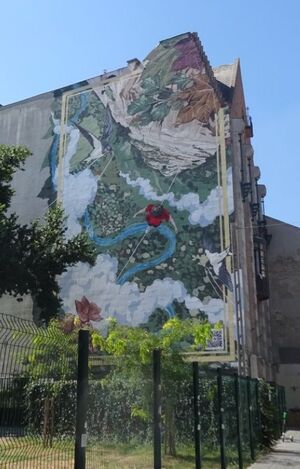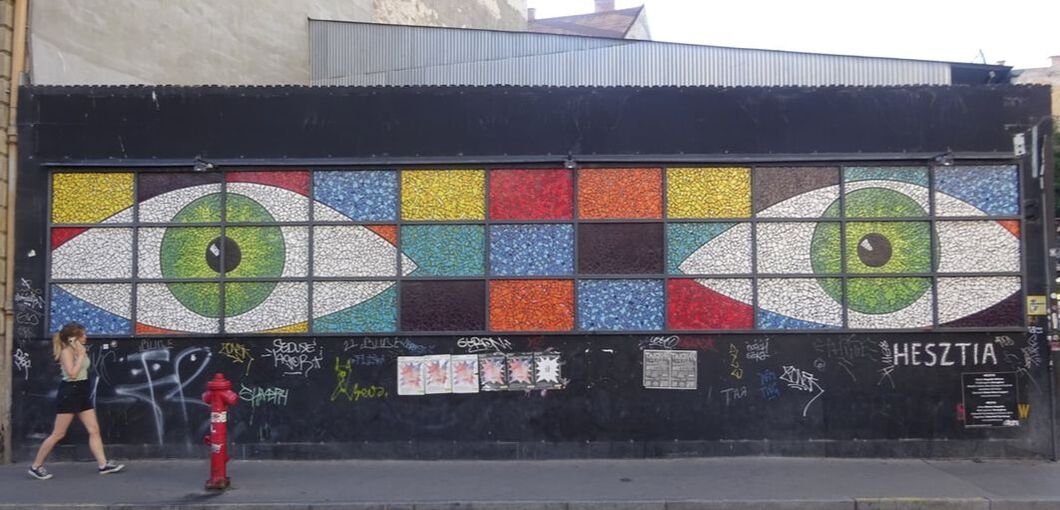Some giant murals of Budapest - side view of a top view over a river, and Rubic's Cube, its developer a local.
Our tour of the Synagogue and the Jewish quarter begins. We start at the Dohány Street Synagogue, also known as the Great Synagogue or Tabakgasse Synagogue, the largest synagogue in Europe seating 3,000 people. A good frontal view is not happening with the lovely trees growing in front.
In 1944, the Dohány Street Synagogue was part of the Jewish Ghetto. Over 2,000 of those who died in the ghetto from hunger and cold during the winter 1944-1945 are buried in the courtyard of the synagogue.
Memorial wall for those non-Jews that risked their lives to save the lives of Jewish people in Budapest.
A stainless steel tree of life, a memorial paid for by actor Tony Curtis and his daughter Jamie Lee. Rick Steves': "Beginning in 1990, Curtis and his daughter Jamie Lee Curtis took a renewed interest in their family's Hungarian Jewish heritage, and helped finance the rebuilding of the Great Synagogue in Budapest, Hungary." The leaves have embossed names of those who perished from the Holocaust.
Interesting rooftop architecture, with an overview taking in all the activities surrounding the synagogue over the decades.
Memorial plaque, an interesting Sedar plate, and a 3rd century Roman-era Jewish headstone.
We continued walking about the historical Jewish quarter. With the circumstances of WWII, including unintended neglect and aerial bombs, and then continuing neglect during Communism, the neighborhoods continued to decay. But slowly over the last few decades, the structures and spirit are returning, although with limited but still present Jewish peoples.
We grabbed some late lunch at a food trailer market set-up in an area awaiting future redevelopment.
Some structures have become "Ruin Bars", rustic, laid-back gathering and imbibing places.
Another nearby synagogue, and also having been resurrected after much wearing-down during the 20th century.
We walked through a developed alley, with clubs and restaurants, getting this view of the blue skies as we strolled.
Stepping through a building alleyway into a courtyard, we're directed by the tour book to find a portion of the wall that created a Jewish Ghetto during WWII. Segments of wall ran from building to building, hidden in these courtyards. The Nazis created this work to effectively imprison thousands of Jewish residents in their own neighborhoods, cutting them off from the outside world.
This courtyard is in a pretty decrepit condition, but many times the roof is intact and the interiors are nicely remodeled. The buildings have large staircases accessed from the street, where you walk out on ringed catwalks to access the individual apartments from the courtyard side.
A nearby nightclub entrance with humorous cat graphics.
How about these apartment units, hovering over the street!
Another synagogue is found.
As we've seen elsewhere in Europe, Budapest has a number of these bronze markers, "Stumbling Stones", placed in the sidewalk in front of various apartment buildings. These memorialize actual residents lost to the Holocaust, taken from these very locations during WWII.
Ignoring the silly graffiti, here's another memorializing installation, to Carl Lutz, the "angel" on the wall, Swiss statesman who set up safe-houses around Budapest, registered as Swiss soil, where many Jewish citizens were able to take refuge and be protected from the Nazi's. He saved ten of thousands from certain torture and death.
Now at "First Brewery" - lot's of good craft beer, a nice break from all the lager and pilsner offerings.
Another site of a razed building, with a temporary alternate purpose.
Finally, a cool skoot waits for its owner to return.






































 RSS Feed
RSS Feed
